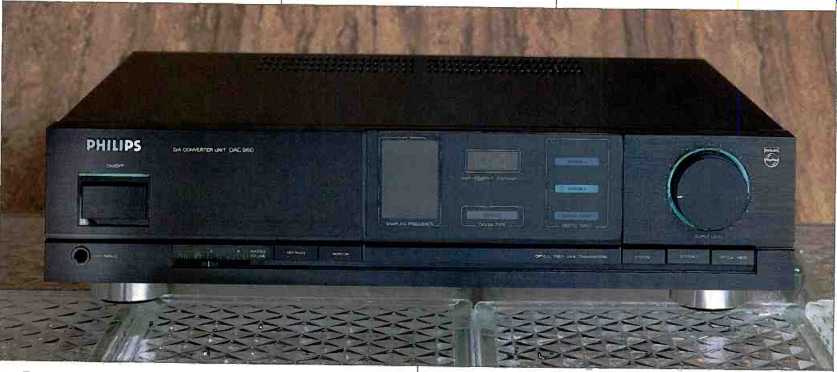
Manufacturer's Specifications:
Frequency Range: Fixed and variable unbalanced outputs, 2 Hz to 20 kHz; balanced outputs, 20 Hz to 20 kHz.
Amplitude Linearity: 20 Hz to 20 kHz. ±0.1 dB.
Phase Linearity: ±0.20, 20 Hz to 20 kHz.
Dynamic Range: Greater than 96 dB.
S/N: Greater than 102 dB.
Channel Separation: Greater than 101 dB at 1 kHz.
THD: Less than 0.0015% at 1 kHz.
Input Levels: Systems 1 and 2 inputs, 0.5 V.
Output Levels and Impedance: Fixed (100 -ohm) unbalanced output, 2.0 V rms; balanced ( 600-ohm) output, 2.0 V rms; variable output, 4.0 V rms maximum; digital tape output, 0.5 V.
Dimensions: 16.5 in. W x 3.9 in. H x 14.2 in. D (42 cm x 10 cm x 36 cm).
Weight: 19.8 lbs. (9 kg)
Price: $950.
Company Address: Philips Consumer Products, P.O. Box 14810, Knoxville, Tenn. 37914, USA.
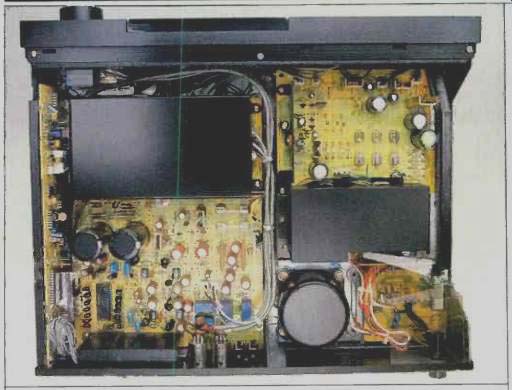
Testing and evaluating Philips' new stand-alone digital-to-analog converter presented quite a dilemma. Once before, I had compared a separate D/A converter with a high-quality CD player's built-in D/A conversion system and had found virtually no difference in sound quality between the two methods of digital audio recovery and reproduction. At the time that I made those tests, my lab equipment was insufficiently sensitive to detect measurable differences between the two approaches. Now I have the more sensitive, computer-driven Audio Precision System One test setup in my lab. Even if my ears failed to disclose significant sonic differences between a top-quality CD player and the digital output of that same player when connected to a separate D/ A converter, I felt certain that measurements would finally "tell all." So, why the dilemma? Simply because most low-cost CD players don't come with digital output jacks; indeed, Philips is perhaps the only firm to offer the feature in players retailing for less than $300. However, the people who might invest in a D/A converter will also want a full-featured CD player, and such a player will probably have D/A conversion circuitry that is fully as sophisticated and precise as the circuitry in a stand-alone converter. Would have more success in differentiating between a high-test player at this time? Read on, and you’ll soon find out!
The Philips DAC960 converter can handle digital inputs having sampling rates of 48 kHz (used in DAT recorders), 44.1 kHz (used in CD players and PCM processors), and 32 kHz (used in European satellite digital audio broadcasting). Because one of several inputs can be selected, the converter resembles a preamplifier/control chassis. There are two wired digital inputs as well as an optical input. The DAC960 also has a tape monitor "loop,” consisting of tape in and tape out jacks for connecting the digital output and inputs c a DAT recorder. The monitor' designation is a bit of a misnomer, inasmuch as you can't really monitor results while in the record mode of a DAT machine. In fact, when recording with a DAT unit via the converter, the Philips owner's manual (printed in seven languages) warns against pressing the "Monitor" button on the front panel. This button is used strictly for playback of a DAT recording-not for true monitoring in the sense that we normally think of that term.
Since I was still in possession of the Philips CD960 Compact Disc player (also reviewed in this issue), I had an opportunity to connect these components together using optical coupling cables. The accessory bag supplied with the DAC960 provided two kinds of optical coupling cables, each about three feet in length. When this unit was produced, the industry was still in the process of standardizing the type of optical connector to be used for this application.
It is my understanding that such a standard has now been agreed to by major digital equipment manufacturers, and the type chosen is, in fact, the one that I found packed with both the Philips CD player and the D/A converter.
If you've never handled optical coupling cables, you should be aware that although they can be bent in a gentle curve, they should never be bent sharply. After all, a kink in these cables will prevent the light beam from travelling from one end to the other.
You can listen to the output of the DAC960 via head phones having any impedance between 8 and 1,000 ohms.
Balanced outputs, using proper XLR connectors, as well as fixed and variable line-level unbalanced outputs, using ordinary phono-tip jacks, are provided; all digital inputs and the digital tape output employ phono-tip jacks. With the exception of the XLR connectors, all jacks are gold-plated for good, permanent, non-oxidizing contact. The optical input is protected by a removable plastic plug when it is not in use.
As supplied, the tips of the optical cables are also protected with soft plastic covers at each end that must be removed before using the cable.
Control Layout
The all-black front panel of the DAC960 has a large, rectangular "On/Off" pushbutton at the left end. When power is applied, a soft blue indicator light illuminates along the top edge of the switch. The phones jack and its associated slider level control are at the lower left of the panel. Two pushbuttons adjacent to the slider control handle the "Monitor" function and invert audio signal polarity if, for some reason, an inversion occurs elsewhere in your signal chain and you want to restore correct absolute phase to your music (assuming you can hear the difference).
A very subdued display area near the center of the panel shows the sampling frequency of the digital program source currently selected. Decimals are omitted, so the readouts are "48 kHz," "44 kHz" (instead of 44.1 or 44.05), and "32 kHz." I rather wish that this display had been a bit brighter, as I found that the numbers were almost invisible in a well-lit listening room. Another pair of displays is to the right of the sampling frequency indicators. One lights up with the initials "DA"; the other displays the word "Monitor" when the "Monitor" button has been pressed. Three more illuminated displays further to the right show which input has been selected ("System 1," "System 2," or "Optical Fiber"). Three input selector buttons are at the lower right of the panel, below a large rotary "Output Level" control which adjusts the level appearing at the variable output jacks on the rear panel.
Measurements
Initially, I attempted to compare performance of the Philips DAC960-when coupled optically or digitally hard-wired to the Philips CD960's digital output-with performance of the CD960 using its own D/A circuitry and analog outputs.
Figure 1 shows three frequency response sweeps superimposed on each other; there is not much point in attempting to identify which is which. Suffice it to say that one curve was derived from the left and right analog outputs of the CD player, while the other two were measured at the left and right outputs of the D/A converter when it was connected, digitally, to the payer (either optically or by hard-wiring of the digital-to-digital interface). Not only are the response curves identical (within about 0.1 dB) for all three sweeps, but, fudging by the very slight ripple at the high end, it would appear that Philips is even using the same gentle analog filters after D/A conversion in both units!
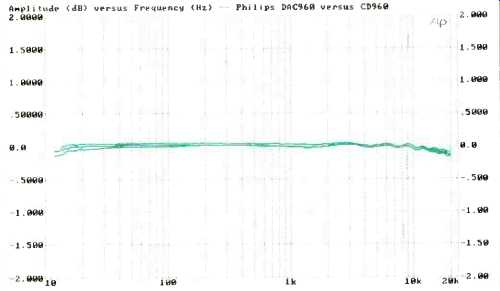
Fig. 1--Comparison frequency responses of Philips CD960 alone, CD960 and DAC960
coupled via optical link, and CD960 and DAC960 coupled via hard-wired link.
To confirm this, I measured amplitude and phase response of the converter. Results are shown in Fig. 2A, and the dashed curve represents the phase response; it did not deviate by any measurable amount from perfect in-phase relationship. Turning to the player for comparison, I repeated this test, and results are shown in Fig. 2B. Again, not the slightest amount of phase shift is evident! At this point, frustration was beginning to set in. Surely the DAC960 must have some performance characteristics that are better than those of the CD960! So, next 1 compared THD + N versus frequency for both units, for maximum recorded signal levels. Results are shown in Fig. 3, with the solid curve representing the converter's performance and the dashed curve representing the player's. Again, results are so close that any difference must be attributed to small differences in each unit's reference output level. Even the shape of the curves is very similar.
I took a spot check of signal-to-noise ratios for the two units. Measured via the wired interface, using the DAC960 in combination with the CD960, S/N was exactly 112 dB (A weighted) referred to maximum recorded level. Mea6ured via the optical interface, the result was exactly the same. So much for the S/N benefits attributed to optical coupling, I thought. But then I decided to analyze the noise content itself, using spectrum analysis. Figure 4A shows the results.
If anything, noise from the converter (solid curve) is actually a bit higher in overall level than from the player (dashed curve)!
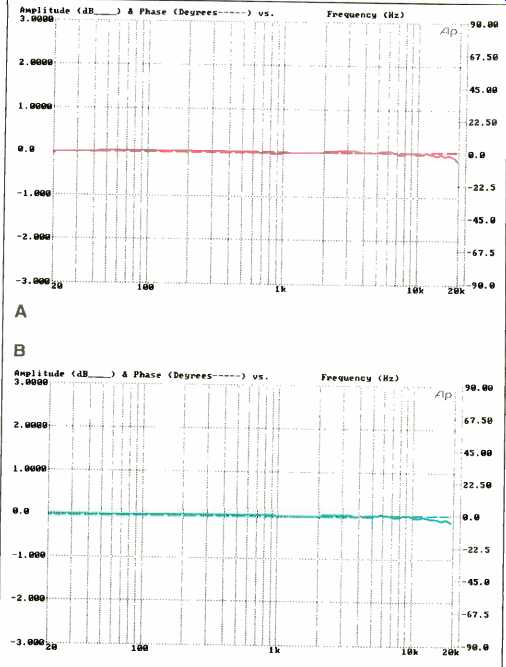
Fig. 2-Amplitude and
phase responses for Philips DAC960 and CD960 combination (A) and for CD960
alone (B).

Fig. 3--THD + N vs. frequency: solid curve is Philips DAC960 and CD960 combination,
dashed curve is CD960 alone.
By this time, I was about ready to scrap this whole project. Having invested a good part of a day so far, though, I decided to try one more experiment. I own a two-year-old CD player, a Sony Model CDP-650ESD which I regard as my "reference" player. Because it is two years old and has a digital output (albeit hard-wired, not optical) and because the state of the art moves relentlessly onward in the world of digital audio, I thought, perhaps, that a check of this "old" unit's noise spectrum compared to the new DAC960's might prove instructive. It did! As shown in Fig. 4B, I had finally found a CD player that could benefit from the use of a D/A converter. The dashed curve is an analysis of the Sony's noise, and you can see a distinct peak at 180 Hz that is not evident in the DAC960's noise spectrum!
When I measured THD + N as a function of signal amplitude (referred to maximum output, in dB) using the DAC960/CD960 combination and the CD960 alone, it was a tossup. At very low signal levels, from-60 dB downward, he DAC960/CD960 combination (solid curve in Fig. 5A) did a bit better than the CD960 alone (dashed curve in Fig. 5A).
At higher signal levels, the CD960 measured alone produced lower THD + N. So, again, I introduced my "old" Sony player into the test scheme, and, again, the DAC960/ CDP-650ESD combination performed measurably better than the CDP-650ESD alone (Fig. 5B).
Next, I looked at stereo separation as a function of frequency for the Philips converter and player combination and for the Philips player alone. The two pieces slightly exceeded the published specification of 101 dB (at 1 kHz), but the CD960 measured directly actually did better. As shown in Fig. 6, it yielded separation of more than 110 dB at 1 kHz and maintained a very high separation level out to 16 Hz, the highest frequency used for this test.
I've saved the really significant measurement differences or last. Using an undithered signal whose amplitude ranged from 0 to -90 dB, I compared deviation from perfect linearity for the DAC960/CD960 combination with the CD960 alone. In Fig. 7A, you can see that the combination's deviation at-90 dB was somewhat less than that of the player alone. The same held true when I compared deviation from linearity for the Philips converter/Sony CD player combination versus the deviation of the Sony player measured directly (Fig. 7B).
The EIA Standard Test Disc (CD-1, produced by CBS Records) also carries a low-level, dithered signal which extends downward from-70 dB. In this test, the DAC960/ CD960 combination again yielded less deviation from perfect linearity than did the CD960 alone (Fig. 8). Yet, when I used the "fade-to-noise" track of the test disc (which offers dithered signal levels from - 60 to -120 dB below maxi mum recorded level), the reverse seemed to be true. I observed somewhat greater deviation from perfect linearity at ultra-low levels for the DAC960/CD960 combination (Fig. 9A) than for the CD960 alone (Fig. 9B).
Somewhat more significant benefits of the separate D/A converter became obvious when examining the actual out puts from both setups, using a-80 dB test signal. The top trace in Fig. 10 represents the output from the D/A converter (driven from the CD960), and the bottom trace is the output waveform of the CD960 itself. Clearly, the top waveform is better defined; there is much more unwanted r.f. noise at the CD960's output.
The final lab measurement was conducted using the last track of the test disc. Dubbed a "Monotonicity" test, this track features a special square-wave signal. The peak of the waveform starts at "digital zero" and increases by 1 LSB (least significant bit) every five cycles, going to a maximum of 10 LSB. The frequency of the square wave is 1,102.5 Hz, exactly 1/40th of a Compact Disc's sampling rate. Ideally, the steps should always increase on the positive side and decrease on the negative side. The steps should also be equal in size; lack of uniformity in step size contributes to distortion in reproduced waveforms. It is clear in Fig. 11 that the DAC960/CD960 combination (top traces) comes closer to this ideal than does the CD960 alone (bottom traces).

Fig. 4A--Spectrum analysis of residual noise; solid curve is Philips DAC960
and CD960 combination, dashed curve is CD960 alone. Fig. 4B--Spectrum analysis
of residual noise: solid curve is Philips DAC960 and Sony CDP-650ESD combination,
dashed curve is CDP-650ESD alone.

Fig. 5A--THD + N vs. amplitude; solid curve is Philips DAC960 and CD960 combination,
dashed curve is CD960 alone. Fig. 5B--THD + N vs. amplitude; solid curve is
Philips DAC960 and Sony CDP-650ESD combination, dashed curve is CDP-650ESD
alone.
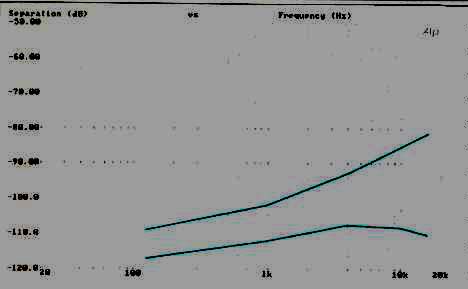
Fig. 6--Separation vs. frequency for the Philips DAC960 and CD960 combination
(top curve) and for the CD960 alone.
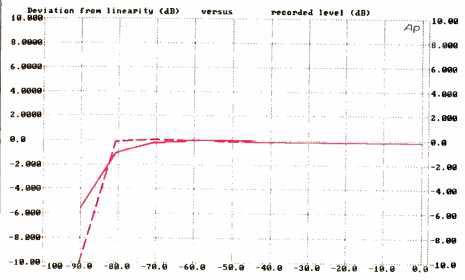
Fig. 7A—Deviation from perfect linearity vs. level; solid curve is Philips
DAC960 and CD960 combination, dashed curve is CD960 alone.
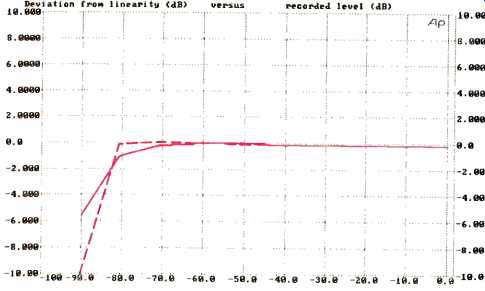
Fig. 7B--Deviation from perfect linearity vs. level; solid curve is Philips
DAC960 and Sony CDP-650ESD combination, dashed curve is CDP-650ESD alone.
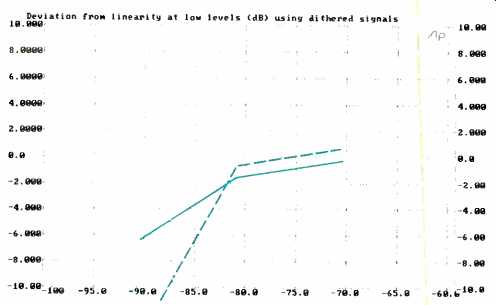
Fig. 8--Deviation from perfect linearity using low-level, dithered signals;
solid curve is Philips DAC960 and CD960 combination, dashed curve is CD960
alone.
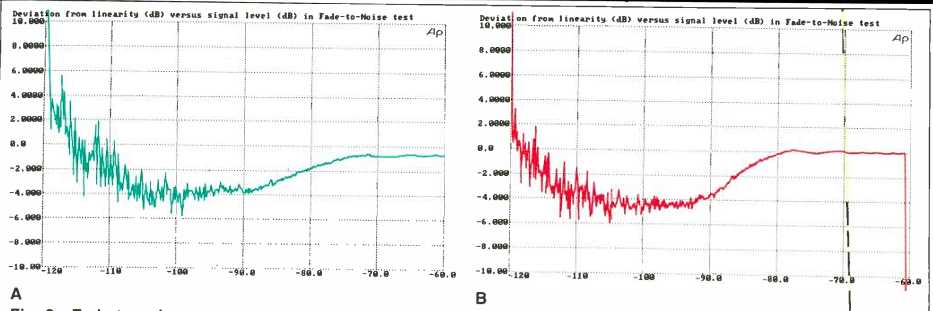
Fig. 9--Fade-to-noise curves for the Philips DAC960 and CD960 combination
(A) and for the CD960 alone (B).
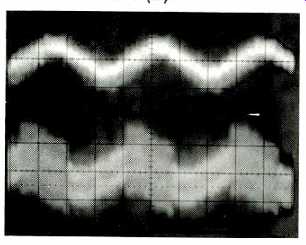
Fig. 10--Sine wave at -80 dB reproduced by the Philips DAC960 and CD960 combination
(top) and by the CD960 alone (bottom).
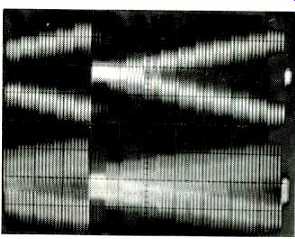
Fig. 11--Monotonicity test reproduction by the Philips DAC960 and CD960 combination
(top) and by the CD960 alone (bottom).
Use and Listening Tests
The Philips DAC960 D/A converter is certainly easy enough to hook up to the digital outputs of a CD player or DAT recorder. Recovered analog outputs are, of course, equally easy to send along to your preamplifier, integrated amplifier, or receiver. I preferred using the fixed analog outputs rather than the variable ones simply because inadvertently setting the front panel's level control to maximum would result in an output of 4 V-perilously close to the overload point on some preamplifier input stages. If you need the convenience of a volume control (e.g., you've decided to go directly from the DAC960 outputs to the inputs of a power amplifier, to avoid further analog signal processing), then the option of using the variable output jacks would, of course, be welcomed.
For the listening tests, I went through more than a dozen of the marvelous little "pocket classic" 3-inch CDs recently released by Delos. Using the same setups as in the bench tests, I switched back and forth between the outputs of the DAC960 and the direct outputs of the CD960, after first making absolutely certain that levels were within 0.1 dB. I listened to everything from A Sonic Odyssey (Delos D/PC 2001, a potpourri of spectacular selections) to Haydn's "Trumpet Concerto" (Delos D/PC 2006), as well as to sever al of my favorite Telarc discs. In all honesty, I could not detect a sonic difference between the two setups. Every once in a while, I thought I heard a bit more graininess on low-level passages when I switched to the CD960 player alone. A few minutes later, when I repeated the test, the differences eluded me. It almost goes without saying that switching from optical to hard-wired interconnections did not yield different results.
When I added my older "reference" CD player to the equation and compared its sound with that of the DAC960/ CD960 combination, I must admit that the improvement offered by the Philips combination was immediately apparent. It didn't take a whole lot of auditioning or program selection to detect it, either. Then again, comparing the Philips player alone against my older "reference" player also resulted in a consistent vote in favor of the Philips player. So, perhaps the conclusion is this: If, like me, you paid a lot of money for a CD player two or three years ago that you can't bear to part with, and if that player has a digital output, you may want to take it down to your local Philips dealer. Have him plug your player into a DAC960 converter, and see if you hear the kind of subtle differences that I heard. Listen in particular to very low-level music passages. On the other hand, if you are not that sentimental about your trusty CD player, you may do just as well by opting for one of the "new generation" players such as the Philips CD960.
Of course, if and when DAT becomes a factor, having a central component to which pure digital signals can be fed from both a CD player and a DAT recorder may be a convenience that we won't be able to resist. However, I am told that all-digital preamplifier/control units are on the way that will fill this requirement and provide additional flexibility besides.
-Leonard Feldman
(Source: Audio magazine, Jun. 1988 )
Also see: Philips CD960 Compact Disc Player (Jun. 1988)
Philips CD880 Compact Disc Player (Jan. 1989)
Philips LHH 500 CD Player (Apr. 1992)
Philips LHH1000 compact disc playback system (Jan. 1990)
Magnavox CDB650 CD player (Mar. 1987)
Marantz CD-94 CD Player and CDA-94 D/A Converter (Aug. 1988)
= = = =